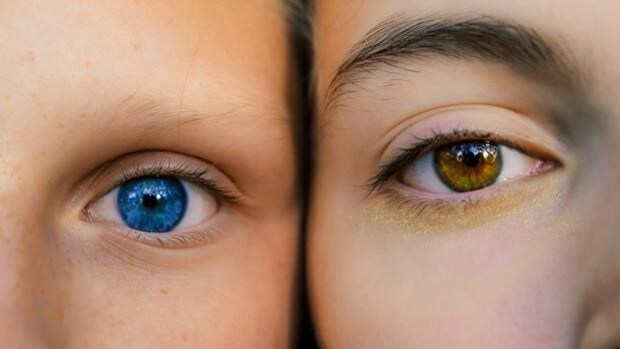 When asked, "What do you look for when judging a person's attractiveness?", many people answer that eye color is decisive. Blue is more popular than any other color, perhaps because it's much less common than brown. Although, more rare and exclusive, the color of actress Liz Taylor's captivating gaze, a violet shade reminiscent of science fiction, is a little more unusual.
When asked, "What do you look for when judging a person's attractiveness?", many people answer that eye color is decisive. Blue is more popular than any other color, perhaps because it's much less common than brown. Although, more rare and exclusive, the color of actress Liz Taylor's captivating gaze, a violet shade reminiscent of science fiction, is a little more unusual.
In our daily lives, we often wonder why children of the same parents have inherited completely different eye colors. Doesn't this follow a conventional pattern of typical Mendelian genetics? What determines this trait? Why, for example, are there more than twice as many women with green eyes as men?
The long road of color
Most people around the world have eyes of various shades of brown. However, there is greater diversity among people of European origin. In addition to brown—the most common—there are other colors that are practically absent in populations on other continents. These include blue, gray, green, and amber.
Such variety can't exist by chance. If evolution has favored the existence of different iris shades, there must be a reason. However, the truth is that both the physiological function of iris color and its possible biological advantages remain a mystery.
There's not so much ignorance about skin color. We know that this trait is associated with the intensity of ultraviolet radiation. And that evolution selects for lighter skin as we move away from the equator.
This is because a balance is needed between protecting the skin from ultraviolet radiation and the production of vitamin D, which is stimulated by the sun's rays. Excessively pigmented skin at very northern (or southern) latitudes could lead to a deficiency of this vitamin and health problems, especially in bone formation. But none of this seems to have a direct relationship with eye color.
What we do know is that the color of the iris depends on three fundamental parameters:
The type of pigment, eumelanin for dark brown-black and pheomelanin for reddish brown; the quantity and distribution of melanosomes, the tiny pigment-laden sacs within epithelial cells; variations in the fine structure of the iris, the charming contractions and mysterious knots we can observe especially in light-eyed people.
And what about genes? In 2007, the first genome-wide study was conducted in European populations, identifying 10 genes involved in this trait. This study was subsequently replicated, and the genes confirmed by another team of researchers. This led to the development of an eye color prediction system based on genetic data, known as Hirisplex.
However, it wasn't a completely reliable prediction system. It worked very well for discriminating between brown and blue eyes, but was relatively inefficient for other colors.
Why? Because they had fallen short. This is demonstrated by a study published this year, based on the largest number of volunteers recruited to date—almost 200,000. The authors identified a total of 52 different genes that influence eye color. That's more than fifty!
It seems clear that we are dealing with a complex biological trait. This is nothing like the inheritance of blood types or the color of Mendel's pea flowers we were taught in high school.
Genetics of complex traits
This is just one example of what the so-called genetics of complex traits holds in store for us. One of the biggest beneficiaries will be forensic science, since we will soon be able to predict, from a drop of blood or a piece of bone, not only skin and eye color, but also other more complex morphological traits.
Without going any further, a recent Spanish study sheds light on the appearance of Paleolithic hunters. They were black-skinned and had blue eyes, a phenotype absent in modern European populations and completely unexpected.<img src="»https://counter.theconversation.com/content/158802/count.gif?distributor=republish-lightbox-advanced»" alt="»The" conversation» width="»1″" height="»1″" style="»border:" none !important; box-shadow: margin: 0 max-height: 1px max-width: min-height: min-width: opacity: outline: padding: text-shadow: !important» />
Antonio José Caruz Arcos is a professor of Genetics at the University of Jaén.
This article was originally published on 'The Conversation'.
